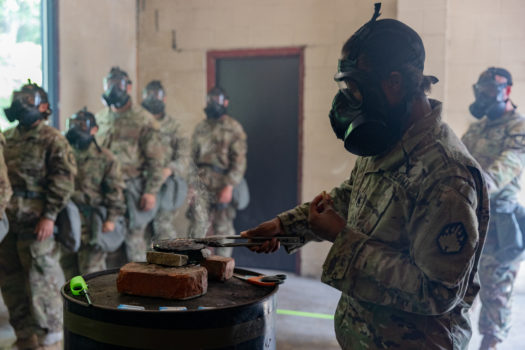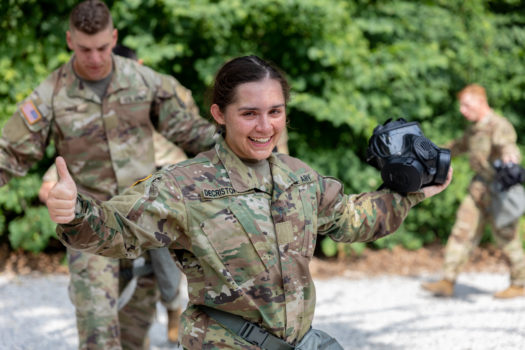“I’m kind of nervous because I generally have a weak stomach, but I’m also excited because it’s something that all soldiers do, and I haven’t done it yet, so I want to get it done,” DeCristofaro said.
6th Regiment Cadets participated in Chemical, Biological, Radiological, and Nuclear (CBRN) training as part of Cadet Summer Training at Fort Knox, Ky.
Cadet Marissa DeCristofaro from Sacramento State had never experienced the confidence chamber before.
“I don’t want to throw up. I think that’s what I’m most worried about is throwing up,” DeCristofaro said.
On the other hand, Cadet Chandler Ard from the University of Alabama believed the confidence chamber would be fun and he was ready to conquer it.
“I’m sure I’m going to be coming out like stuff coming all out of my face, coughing pretty bad, but you know maybe it will clear me out,” Ard said.

Once the Cadets entered the chamber, Staff Sgt. Regina Tejano ignited the CS capsule. She then led the Cadets in various exercises including breathing and head movements which reassured the Cadets they can rely on their protective masks.
In order to elevate their heart rates, Tejano instructed the Cadets to perform a high knees exercise before they removed their masks and were exposed to the CS gas for 15 seconds.
“Normally they panic because they feel the burning sensation along their exposed skin, like the forehead, the eyes, the hands, the back of the neck,” Tejano said.
Due to the fact that the CS was a highly concentrated chemical, Tejano said the Cadets oftentimes gasp for air once being exposed.
“It’s like the same experience you feel when you eat a habanero or any type of spicy pepper,” Tejano said.

DeCristofaro initially felt fine walking into the chamber with her mask on, but it didn’t take long for her to feel a burning sensation on her neck and hands.
“They had us take our masks off completely and that’s when my eyes were burning, my lungs were burning, parts of me that I didn’t know could burn were burnt, like everything was burning,” DeCristofaro said.
The Cadets sang the national anthem and after 15 seconds were released from the chamber.
“When they finally started filing out it was like the slowest five seconds ever. I was counting the seconds before I could go outside, and when you go outside there’s still no relief. Your eyes are like glued shut, but you have to keep opening them and it’s still just painful,” DeCristofaro said.
When the Cadets exited the chamber, they were directed to walk in a circle and move their arms up and down in order to remove the CS gas from their uniforms and out of their lungs so they could breathe properly.
“It’s been, I don’t know 10 or 15 minutes since I’ve been in and now I feel perfectly normal,” DeCristofaro said.

While DeCristofaro felt the gas chamber was much worse than she predicted, Ard believed it lived up to his expectations.
“Honestly, it’s kind of about what I expected,” Ard said. “Maybe a little worse, but I’d do it again. I thought it was kind of fun.”




